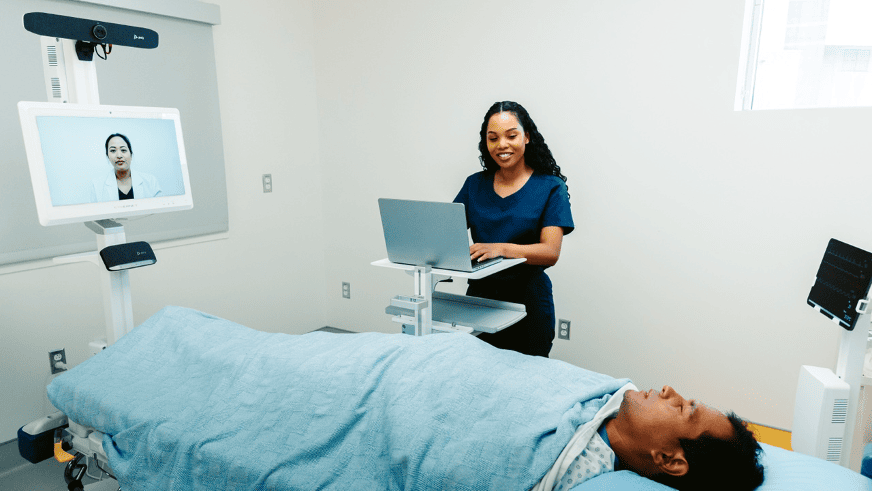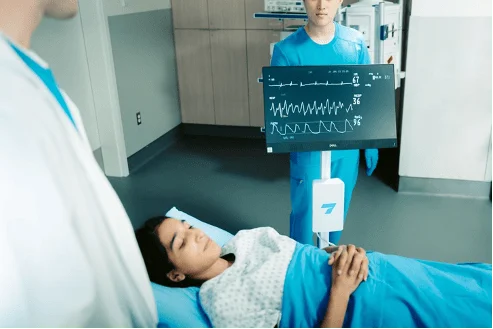
In our fast-paced world, technology continues to reshape every aspect of our lives. From how we communicate to how we access information, there’s no denying that the digital age has revolutionized our world in ways we could not have fathomed just a few decades ago.
Now, imagine a world where healthcare is no longer bound by physical barriers, where distance, time zones, and geographical limitations are no longer hurdles in receiving quality medical care. Telemedicine taps into the power of digital health platforms to deliver remote medical care, offering patients various possibilities, including primary care, psychotherapy, physiotherapy, emergency assistance, and more through video chat or phone calls.
Telemedicine relies heavily on tools like smartphones, computers, and tablets. Some common examples of telemedicine technology are virtual visit platforms, patient monitoring portals, personal health apps, and electronic health record systems.
Telemedicine embraces three key types of telecommunications technologies, each catering to distinct purposes:
Since its development in the 1950s, telemedicine has grown significantly, becoming increasingly widespread and revolutionizing the healthcare industry.

As telemedicine is performed entirely remotely, transportation time and expenses are saved. At the same time, even patients in remote or rural areas can use these services to receive urgent or specialist care. For example, Capsa Healthcare’s Trio Telemedicine Workstation is an innovative hospital computer cart designed to facilitate virtual care and timely diagnostics through video communication and diagnostic peripherals. This real-time connection between doctors and remote patients significantly improves access and the timeliness of care.
In many cases, the problem can be resolved remotely, eliminating the need for a personal visit or hospital stay, thereby reducing treatment, follow-up, and rehabilitation costs and making healthcare more affordable for patients while easing the financial burden on service providers.
Telemedicine’s ability to slash operating costs has been impressive, with some facilities or practices reporting up to a remarkable 50% reduction in expenses when patients opt for telemedicine services over traditional on-site visits. Consequently, many healthcare organizations are actively seeking to expand and upgrade their telehealth workstations to boost financial growth and elevate patient care delivery.
Telemedicine solutions decrease the need for front-desk support staff and large spaces for medical exam rooms and waiting rooms. By saving on costs for outpatient care, more resources can be directed toward patients requiring admission.
With the use of tools like online appointment booking and appointment reminder messages, patients can take charge of their own health appointments through mobile devices and eliminate the need for dedicated staff for such activities.

With remote patient monitoring, healthcare professionals can check on a patient’s vital signs, eating and sleeping habits, medication compliance, and recovery status. This is particularly beneficial for patients with chronic diseases because they require longer periods of care.
Healthcare providers can also monitor the patient’s environment, identify any issues that could hamper the patient’s recovery, and eliminate any confounding factors that might negatively influence patient care.
Not only can telemedicine reduce operating costs, but it can also increase overall revenue by reaching out to entirely new patient populations beyond any geographical limits. Even patients in other states can access healthcare services that may not be available where they live.
Additionally, healthcare providers are more likely to retain existing patients and boost patient loyalty by scheduling online follow-up visits. Patients looking for second opinions can also easily find experts in a specific field through telemedicine services.
Finally, lost revenue through patient no-shows can be minimized, as patients can match their schedules to their doctor’s availability, easily reschedule appointments, and save time and money via virtual visits. The decrease in canceled appointments can also boost staff efficiency.
With telemedicine services, patients with infectious conditions or low immunity can be quarantined effectively while retaining access to high-quality medical care.
This is particularly useful in situations like the COVID-19 pandemic, where the spread of infection can be strictly controlled by minimizing patient exposure to the general population, including other patients and healthcare providers. Protecting the safety of medical providers is particularly important in challenging times when the patient burden is high, and the availability of healthcare providers is limited.
According to a recent study, more than 80% of patients preferred telemedicine visits and liked that they could reach their doctor via video conference at their convenience. Furthermore, more than 95% of patients were satisfied with the quality of care they received through a virtual visit.
With telemedicine, patients can have better access to specialists like neurologists or cardiologists, who are usually in great demand. In the traditional medical system, patients may wait weeks or even months, depending on their location, before meeting a specialist in person. But, through time-saving telemedicine services, these doctors can now accommodate many more patients in their daily schedule, thus drastically shortening wait times.
Additionally, telemedicine services don’t compromise the care quality provided to patients. Research has shown that patients who opt for telemedicine services experience less stress, anxiety, and depression and are less likely to be admitted to the hospital. More than 90% of patients dealing with challenging conditions like cancer also stated that they were satisfied with their telemedicine provider’s advice and found their level of care and concern equivalent to that of in-person visits.
Little River Medical Center (LRMC) in Little River, SC, faced a challenge in providing easy access to healthcare for children in Horry County. Many parents were unable to take time off work to take their sick children to the doctor, resulting in prolonged absences from school for children with chronic conditions. To address this issue, LRMC decided to implement telehealth services in Horry County schools, offering students medical and behavioral health services.

After researching and evaluating various telehealth solutions, LRMC chose Capsa Healthcare’s CareLink Telemedicine Workstation, integrated with the IronBow CLINiC with Poly Codec. The CareLink Telemedicine Workstation is a solution designed to facilitate remote healthcare through advanced video communication and seamless integration of diagnostic peripherals, enabling virtual care and prompt diagnostics. With CareLink, doctors can connect with their patients remotely in real-time, significantly improving access to medical expertise and ensuring timely, efficient care delivery.
The implementation of the telehealth carts brought numerous benefits to students and parents:
LRMC was pleased with the performance of the carts and recommended them to other facilities looking to improve access to medical care through telehealth solutions.
Telemedicine solutions in the healthcare industry have ushered in a new era of accessible and cost-effective medical care. As the world embraces the digital age, the benefits of telemedicine have become evident, with reduced overhead costs for healthcare organizations, enhanced revenue streams, and improved patient satisfaction.
Setting up telemedicine services at your healthcare facility is beneficial. But the type of technology you use is critical to the implementation, efficiency, and value of your system. Capsa Healthcare is a worldwide leader in providing healthcare solutions that can boost productivity, prevent employee burnout, and enhance patient care while meeting the highest industry standards. Visit Capsa Healthcare today to learn more about telehealth carts that can help you stay up to date with the latest technology for all your telemedicine needs.